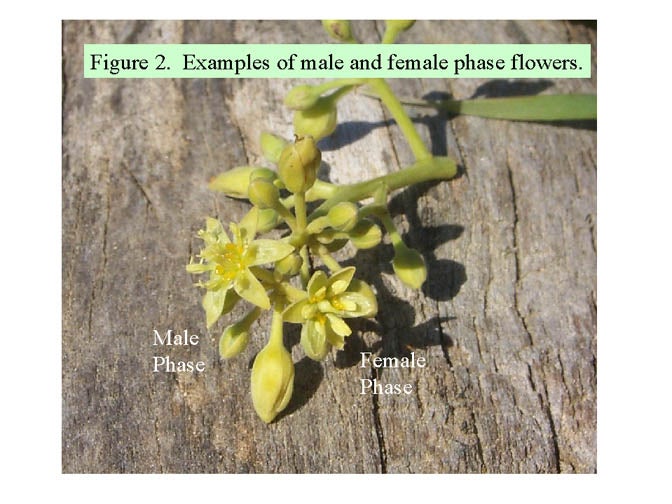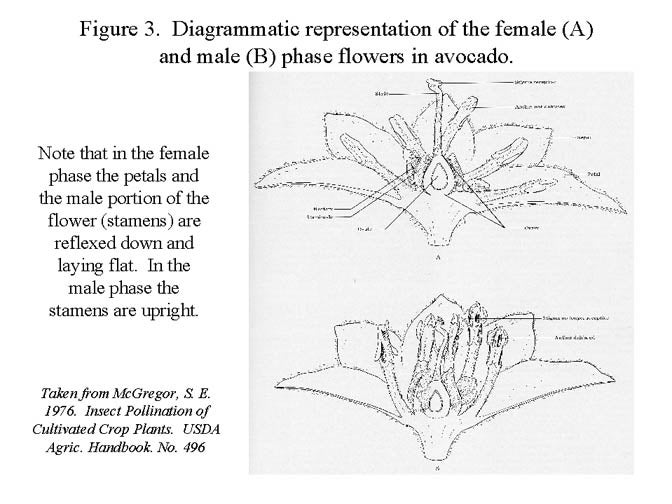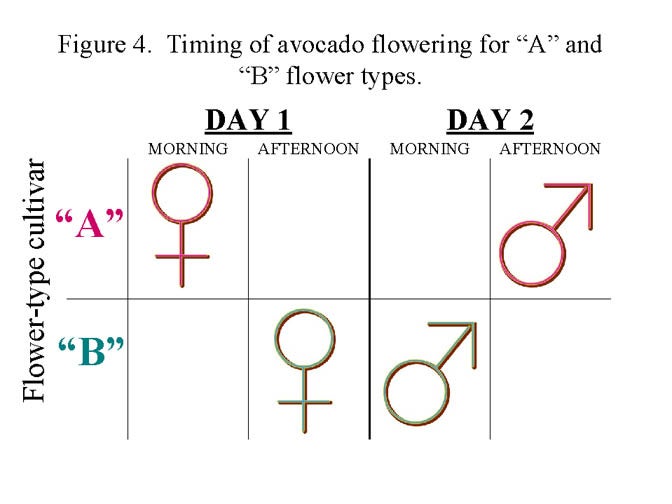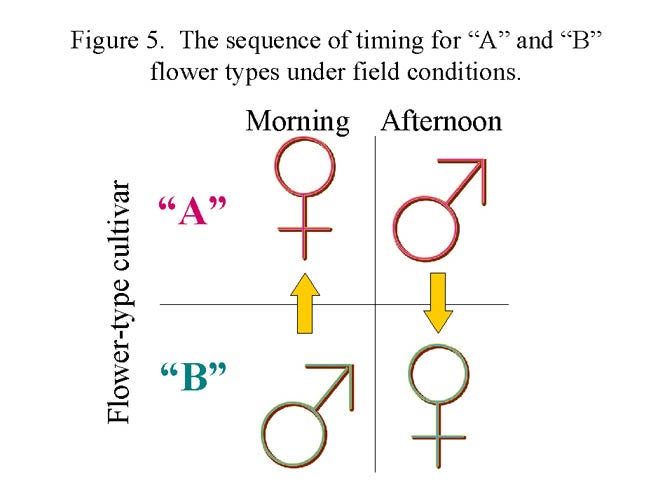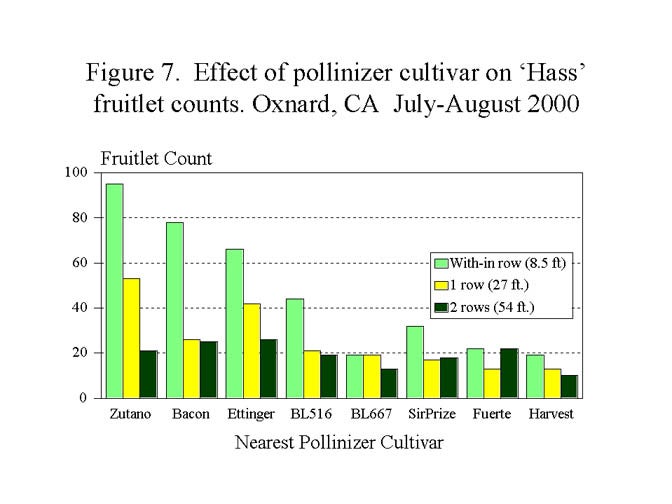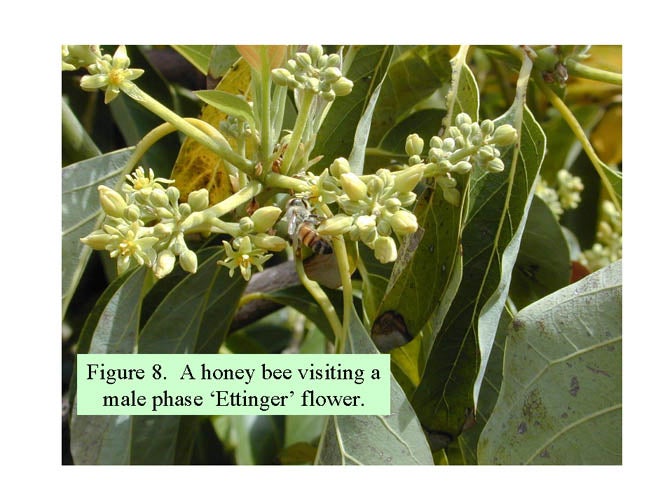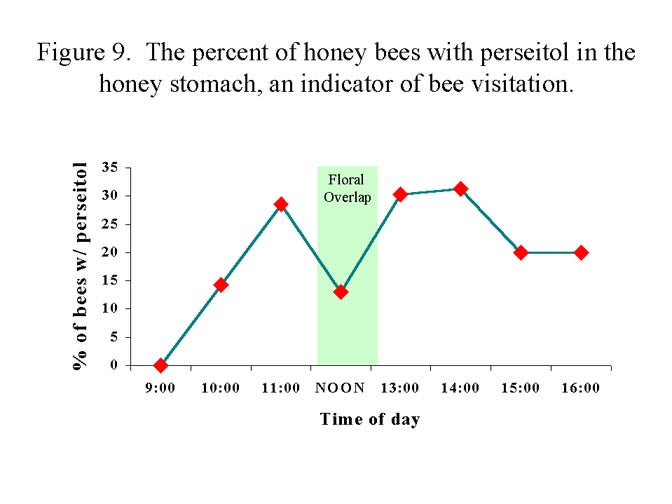M. L. Arpaia | University of California, Riverside
A. E. Fetscher | University of California, Riverside
R. Hofshi | Del Rey Avocado
THE FLOWER
Avocado productivity is influenced by many factors and involves many steps. The critical first step, however, is the process of pollination which leads to fertilization and fruit set. Pollination occurs when pollen is deposited on a receptive stigma. This poster describes some of the considerations pertaining to avocado pollination.
The avocado’s flowering behavior is unusual in many ways. The mature tree can produce in excess of a million flowers during the flowering period. The flowers occur in panicles of several dozens or hundreds of flowers. There are two different types of avocado inflorescences: determinate and indeterminate (see Figure 1). In a determinate inflorescence the tip of the shoot that bears the flowers will end in a flower. Indeterminate inflorescences, which tend to be more common in our environment, terminate with a vegetative bud.
The avocado flower has both functional male and female organs. The male floral organ, which produces pollen, is comprised of the anthers and stamens. The female floral organ is comprised of the stigma (which receives the pollen), style and the ovary.
The avocado exhibits a type of flowering behavior known as "synchronous dichogamy". An individual flower will be open for 2 days, however the timing of the male and female phases are distinct. When the flower first opens it is in the female phase and the stigma is receptive to pollen. At the end of the female phase, which lasts 2 to 4 hours, the flower will close. On the second day the same flower re-opens in the male phase and sheds its pollen. See figure 2 for illustration of the female and male phase flowers.
Figure 3. Diagrammatic representation of the female (top) and male (bottom) phase flowers in avocado. Note that in the female phase petals and the male portion of the flower (stamens) are reflexed down and laying flat. In the male phase the stamens are upright. (Taken from McGregor, S. E. 1976. Insect Pollination of Cultivated Crop Plants. Agric. Handbook. No. 496)
The avocado is also unusual in that the timing of the male and female phases differs among varieties. There are two flowering types, referred to as "A" and "B" flower types. "A" varieties open as female on the morning of the first day. The flower closes in late morning or early afternoon. The flower will remain closed until the afternoon of the second day when it opens as male. "B" varieties open as female on the afternoon of the first day, close in late afternoon and re-open in the male phase the following morning. See Figure 4 for a diagrammatic representation.
Since there are hundreds of flowers on an avocado tree at any one time the actual situation in the field as shown here (Figure 5). The arrows denote the movement of pollen between the complementary flower types.
WHAT ARE THE PRACTICAL RAMIFICATIONS?
Table 1 lists some of the common varieties and their flower type. The avocado’s flowering behavior is believed to promote cross-pollination since the male and female phases of an individual flower occur at different times. It is believed that the interplanting of complementary flower types can boost fruit set and therefore yield by making pollen available.
|
Table 1. Avocado varieties and flowering types.
|
|
|---|---|
|
"A" Varieties
|
"B" Varieties
|
|
Hass
|
Bacon
|
|
Gwen
|
Ettinger
|
|
Lamb Hass
|
Fuerte
|
|
Pinkerton
|
Sharwil
|
|
Reed
|
Sir Prize
|
|
GEM
|
Walter Hole
|
|
Harvest
|
Zutano
|
|
Marvel
|
|
|
Nobel
|
|
| Note: Varieties in italics are from the UC Breeding Program and are currently under evaluation. | |
Unfortunately, most of the currently available "B" varieties are classed as "greenskins", which return less to growers. Two "B" varieties, currently under evaluation by the UC Breeding Program, are ‘Nobel’ and ‘Marvel’. These varieties produce a black "Hass-like" fruit.
The variety that provides pollen to the female phase flower is termed the "pollinizer" variety (Figure 6). There is much discussion as to whether the planting of pollinizer varieties is worthwhile. Figure 7 presents data from a trial established in 1998. The fruitlet count on ‘Hass’ trees planted at varying distances from "B" flower-type varieties is presented. The counts were influenced by the presence of a pollinizer, the pollinizer variety, and the distance from the pollinizer. Note: ‘Hass’ trees planted in 1998 and pollinizer varieties planted in 1999. The ‘SirPrize’ and ‘Fuerte’ trees did not flower in 2000.
DO WE NEED POLLINATORS?
The separation in time of the male and female phases has led most observers to believe that a vector or "pollinator" is needed to move pollen from one flower to another. The European honey bee is the commonly used pollinator. The data from the pollinizer project suggests that the spatial placement of pollinizers may be critical due to the foraging behavior of the honey bee since most honey bees tend to forage in a relatively small radius of 1 to 4 trees.
We have been monitoring honey bee activity on avocado during the last year and have compared the efficiency of two honey bee races (Italian and New World Carniolan). We monitored the percent of the honey bees visiting avocado flowers during the day. Figure 8 shows a honey bee visiting a male phase ‘Ettinger’ flower. We used the presence of perseitol, a sugar unique to avocado, to assay for honey bee visitation. The drop in the middle of the day approximates the time when the female and male flower phases are in transition (Figure 9).
Interesting data has been generated by this project. During the current year we are continuing collaboration with other researchers in Florida and Israel. We hope to further elucidate the mechanism by which pollen is transferred from male to female flowers as well to understand the role of the honey bee. This information will assist growers in making informed decisions regarding the subject of pollination.

